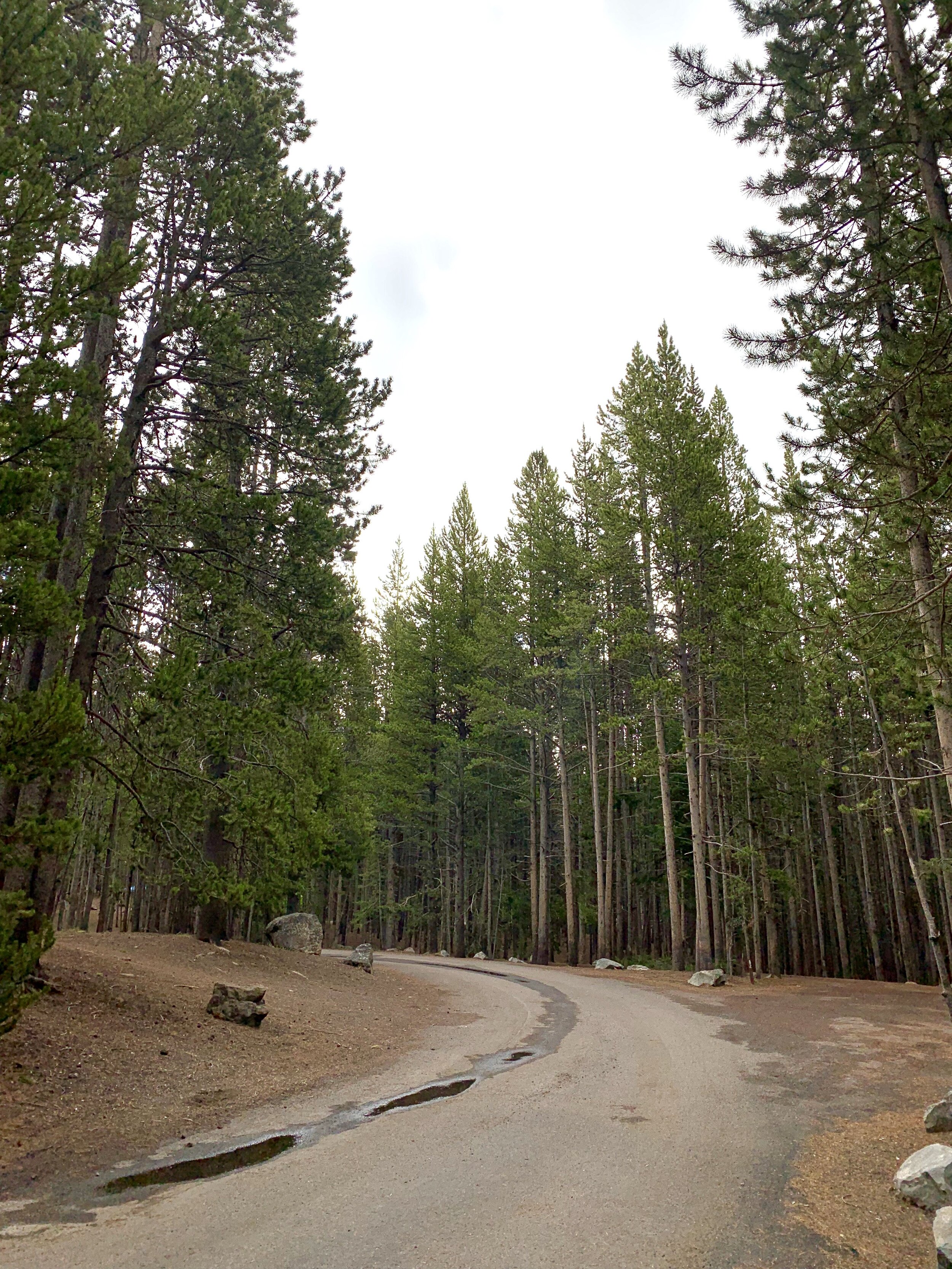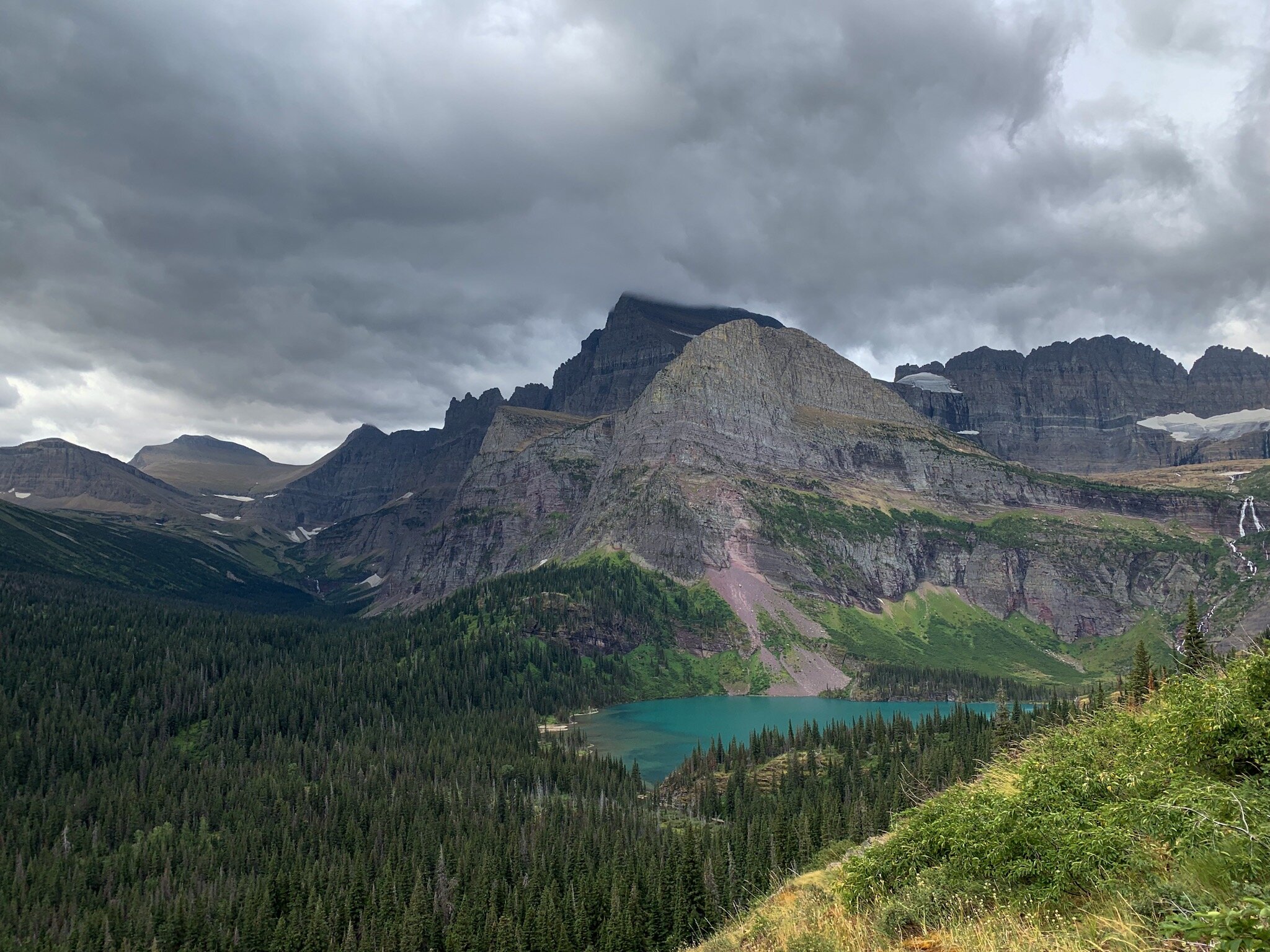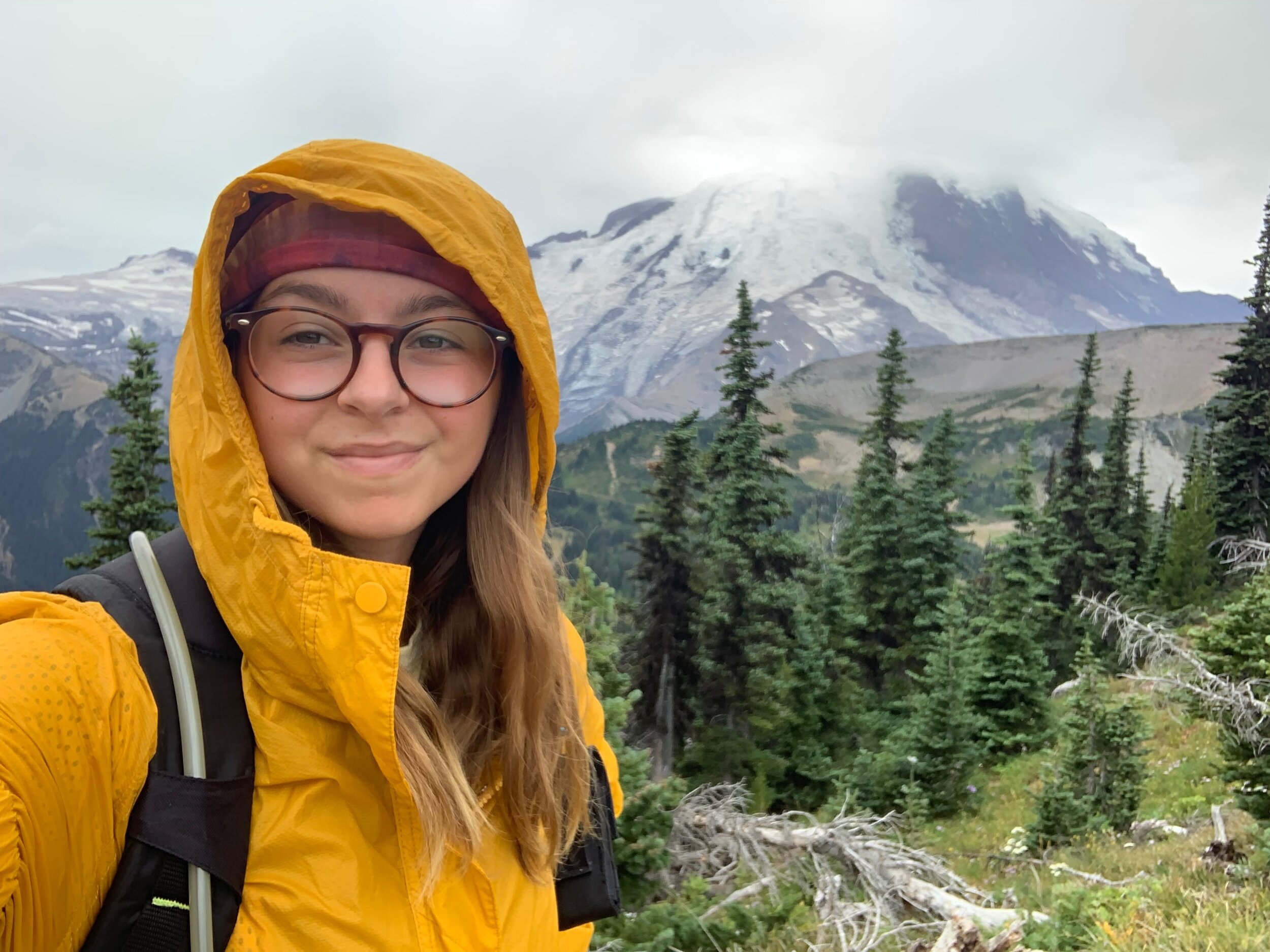Glacier National Park in Montana is truly one of those treasures that can’t be missed in the Lower 48. From its sprawling landscapes to its abundant wildlife, there’s nothing not to love about Glacier. It’s truly my favorite place in the entire contiguous United States. For people who haven’t visited, it often tops their National Parks bucket list, and for those who have been, it’s often a destination they’re trying desperately to revisit. Glacier National Park is a special place, and one that should be visited with care, to protect its rapidly changing natural landscape.
Because Glacier is such a large National Park, with multiple sections, I’ve found that it’s a bit intimidating to people who either haven’t been or who aren’t incredibly familiar with the National Parks System. This blog is here to answer your questions, and to be your essential guide as you plan your first trip to the park.
(Disclaimer: This post may contain affiliate links)
The view from the Logan’s Pass Visitor Center area
Know Before You Go
First, let’s cover the basics. Glacier National Park is located in northern Montana, on the Canadian border. You can cross into Canada from Glacier easily, to explore the Waterton Lakes area. Glacier is located in the center of multiple small towns, including Babb and Whitefish, and bordered on one side by National Forest. On the east side of the park, you’ll find the Blackfeet Indian Reservation of Montana. Due to the proximity of these towns and the preserve, it is important to enter the park with respect.
To enter Glacier National Park for one week, you will be charged a $35 entrance fee per car, or $25 in the winter, when the Going to the Sun Road is closed. I highly recommend investing in an America the Beautiful Pass or other interagency pass if you plan on visiting more than 3 National Parks in one year.
Dogs are allowed in the park, but are not allowed on most trails. They can visit the park in front country campgrounds, picnic areas, roads, parking areas, and in boats. Dogs must be on a leash no longer than 6 feet, and cannot visit the backcountry, lakeshores, or inside visitor centers. If a road is closed to vehicles due to winter weather, it is considered part of the backcountry.
Along the Hidden Lake Overlook Trail
Wildlife
Glacier is home to some of the most abundant wildlife in the country. This Park is largely wilderness, which makes it the ideal place to spot incredible animals, such as deer, black bears, grizzly bears, mountain goats, big horned sheep, and elk. It is also home to more elusive animals like pikas, bats, lynx, mountain lions, and wolverines. This truly is the ideal place to spot wildlife in their natural habitat, and I was lucky enough to see mountain goats, black bears, grizzlies, deer, and big horned sheep during my visit. It’s important to view wildlife here safely, though, and remember, wildlife is wild!
It is not recommended that you visit the park without someone in your party carrying bear spray, which can be purchased at the visitor centers, and any shops in the park. Bear spray is a one-time use deterrent equivalent to a large canister of pepper spray. It is to be used to defend yourself against a bear (usually a grizzly), in the case of danger. Do not spray a bear who is minding their own business, and do not use bear spray indoors or on a person.
Two deer in my site at Rising Sun Campground
When should I visit?
The only time of year you will be able to experience all of Glacier National Park is in the summer. During the winter, the main roads are closed. Keep in mind that winter in northern Montana can range between late September and late June, and no one knows when the Going to The Sun Road will open for the summer season—it all depends on weather.
The best and most popular month to visit is July, since there is still a considerable amount of snow on the mountains. However, I visited in late August, and there was still plenty of beauty to be seen!
Wildflowers blooming in late August in Glacier National Park, MT
Should I stay in East or West Glacier?
This is one of the most common questions when it comes to planning a trip to Glacier National Park. So, which is better? East or West Glacier?
Glacier National Park is divided into three sections, and two of those sections—East and West Glacier—are connected by the Going to the Sun Road, which I’ll cover later in this post. When it comes to which side to visit, my answer is: visit both, if possible! If not, due to weather or time, I would say East Glacier is home to most of what people picture when they picture visiting Glacier National Park.
St. Mary’s Lake in East Glacier
West Glacier is largely forested, and won’t provide you with the views that East Glacier has. However, it is incredibly peaceful, and is a great place to stay if you’re looking for some quiet. It is also home to the only visitor center with legitimate cell service (Agpar Village), so if you need to call home, it might be worth making a stop here. As far as trails in West Glacier, they aren’t quite as impressive as the ones in East Glacier, but they are still worth checking out. The one that should definitely be on your list is Trail of the Cedars, a family friendly short trail that will allow you to get up close and personal with some of the Park’s largest flora.
East Glacier is home to many of the views people want to see during their trip, which is why I suggest heading here if you’re short on time. This is where you’ll find lakes, tall mountains, waterfalls, and views of the valley. You’ll also find a few more amenities in East Glacier, such as WiFi at the St. Mary’s Visitor Center, and a restaurant and motel at Rising Sun. This is also where you’ll find boat parking, and day parking for vehicles over 21 feet.
One of the many beautiful wooded views in West Glacier
What is Many Glacier?
Many Glacier is the third section of the park, and truly one of the most spectacular. To access Many Glacier, you definitely need a car, as the park shuttle doesn’t go here. During 2020, the road to Many Glacier will be under construction, so be prepared for traffic and limited parking. There is also the option to hop on a boat from East Glacier, but this is not ideal for budget travelers.
You will have to show your entrance receipt or pass again when you enter Many Glacier.
Many Glacier is home to the Park’s main hotel, as well as some of the most famous sites in the park: Iceberg Lake and Grinnell Glacier. It’s important to remember that reaching these sites is not for everyone—you will be at elevation, and they are only accessed by trail.
Many Glacier is definitely one of my favorite sections of the park. It’s wild, largely untouched, and home to one of the last true glaciers in the continental US. This is also where I saw my first grizzly bears.
Grinnell Glacier, one of the most beautiful places in Many Glacier
What is the Going to The Sun Road?
The Going to The Sun Road is one of the key parts of a full experience in Glacier National Park. This 50 mile long road will take you from East Glacier to West Glacier, and is only fully accessible to vehicles less than 21 feet long and park shuttles.
Driving this road is not for everyone. It is incredibly windy in the alpine section, and usually crowded. To beat crowds, I suggest hitting the road as early as 6 am. Here, you’ll find overlooks, pullouts, and three visitor centers with unique views and wildlife viewing opportunities. I suggest stopping at each exhibit, and making a whole day out of this unique drive.
My number one tip for experiencing the Going to The Sun Road is to take the shuttle, specifically if you plan on stopping in Logan Pass, the highest elevation on the road. There will not be parking at Logan Pass, as it is the most popular spot in the park, and the site of the High Line trailhead. If you do take the shuttle, when riding from Logan Pass to East Glacier, make sure you sit at a far-right window at least once—this is the best way to get views into the deep valleys below, but definitely isn’t for anyone afraid of heights!
The view from the Going to The Sun Road, heading East
There are also private tours of the Going to The Sun Road. If you would like a guided tour, check out the Red Bus Tours, which are not affiliated with the National Park Service.
Please keep in mind that the road is closed during the winter season, which can range anytime between September and late June, so it is best to plan a summer visit.
The view from the Going to The Sun Road heading West at 6am in late August: A Valley Filled With Clouds
What can I see in the Park without hiking?
Glacier truly is a hiker’s paradise, but if you’re not a hiker, or aren’t physically able to do so, there is plenty you can still experience. The Going to The Sun Road is going to be your best bet for views comparable to those you might see on one of the Park’s longer hikes, and you can see Jackson Glacier from one of the first stops (coming from East Glacier). This is a great spot to stop and take pictures, but truly, any of the pullouts will do—Glacier’s views can’t be beat!
One of Glacier’s many waterfalls, as seen from a pullout along the Going to The Sun Road
What are some family friendly hikes?
If you are traveling with kids, rest assured that there are plenty of hikes with good views that are ideal for families. While the park is a hiker’s paradise, there are quite a few trails that are short, or have little elevation gain (or both!). The first one I’d suggest checking out is the previously mentioned Trail of the Cedars in West Glacier. This magical spot is perfect for families with really young kids, as it does have a boardwalk, allowing those with strollers to experience these magnificent trees.
Another great family friendly hike in Glacier National Park is St. Mary’s Falls. These glacial waterfalls run bright blue, and the entire hike to see all three falls is less than 3 miles (out and back).
The first waterfall you’ll encounter along the St. Mary’s Falls Trail
The last family friendly hike in Glacier that I’d highly recommend is a bit harder because it does gain some elevation, but the view is rewarding. At Logan Pass, you’ll find the Hidden Lake Overlook trailhead. This is the first section to a much longer hike (Hidden Lake), but this part is fairly easy for kids (I saw plenty on the trail). The trail is mostly made of man-made steps, and the peak will give you a spectacular view that can’t be beat. This is also where I saw my first ever mountain goats!
When traveling with kids, it’s important to give them the chance to learn and have fun. Pick up a Junior Ranger booklet at any visitor center, and help them earn a badge they can proudly wear throughout their trip.
View from the Hidden Lake Overlook Trail
Is visiting Logan Pass worth it?
Logan Pass is the highest point of elevation along the Going to The Sun Road, at over 6,000 feet. It truly is not something that should be skipped, and is key to having a full Glacier experience. Logan Pass is probably what I would consider the main visitor center, as it is exactly halfway between East and West Glacier. It is home to the Hidden Lake trailhead, as well as the High Line trailhead, and is integral to the shuttle system, as it is the only place you can transfer shuttles to get to West Glacier (the East Glacier shuttles are too large to go through the alpine section). Logan Pass is key to how the park runs, so make sure you don’t skip it!
In terms of that shuttle transfer, make sure you ask what time the last shuttles leave, and what time you should be back at Logan Pass to make it to East Glacier. The shuttles do stop running before sundown, and if you miss them, your only option will be to hitchhike back.
One of the many views near Logan Pass
What hikes should be on my list?
If you are a hiker, Glacier is the ideal park for you. Apart from backcountry experiences, which you can read more about on the park website, there are two main hikes that you cannot miss during your trip to Glacier.
Disclaimer: please do not attempt without bear spray.
Located in Many Glacier, you’ll find the Grinnell Glacier trail. This 12.8 mile round trip hike will take you through some of the most beautiful landscapes in the park, under a small waterfall, and to one of the last standing glaciers in the continental US. This is a very difficult hike, and it’s recommended that you start early in the morning to find parking and beat the crowds. If you’re not sure of your ability, there are paid ranger-guided hikes that will take you up this trail and to the glacier. This is a hike to try and do as soon as possible. The glacier is melting fast, and will continue to do so due to global warming.
For eco-friendly (and glacier friendly) gear, products, and apparel, check out Madera Outdoor, Eco Roots, and Wholesome Culture, three companies here to make a difference.
Top of the Grinnell Glacier Trail
The other must-hike trail in Glacier National Park is known as the High Line, which connects to The Loop. The High Line itself is a 16 mile out and back ridge hike that is not for the faint of heart—you will be on cliff edges for part of this hike! Most people connect the High Line to The Loop, a downhill trail that will make your trip an 11 mile one-way trip, rather than 16 miles out and back. The Loop, however, doesn’t have much to see, and will be 3 miles of steep downhill (so if you are prone to knee injuries, you might want to opt for the longer trip). The High Line is a spectacular hike with stunning views that will take you to a view of the other side of Grinnell Glacier. Here, you’ll see pine forests, towering mountains, and wildflowers. This is a very popular hike, and I would suggest heading out as early as possible. Since the trailhead is at Logan Pass, it is recommended that you take the first shuttle to the trail, rather than drive.
For either hike, make sure you have the right gear, including a rain layer.
One of the views you’ll catch on your way to Grinnell Glacier
Where should I stay?
There are tons of options when it comes to where to stay in Glacier National Park. One of the best ways to truly experience the park is to camp. While a few of the campgrounds to require reservations (Many Glacier, St. Mary’s, and Agpar), plenty are also available on a first come first served basis, and there are quite a few backcountry campgrounds available as well. On the west side, Avalanche is a good campground to stay in, due to its proximity to East Glacier. This is a great way to experience the West side of the Park at night, and have a shorter ride to the East side and Logan Pass during the day.
My favorite spot in Glacier is Rising Sun Campground. This campground is located in East Glacier, just 6 miles from the St. Mary’s Visitor Center. It is fantastic for solo travelers, and has its own shuttle stop. A stay at Rising Sun will also put you close to one of the park’s only restaurants, as well as a general store and pay showers. It’s also got one of the most unique sunrise views in the park, so make sure you get up early!
For camping in Glacier, I highly recommend using a 0 degree sleeping bag, no matter what time of year it is—it does get very cold at night. THIS is my favorite 0 degree bag, from Madera Outdoor.
There are also a few hotels and motels in the park, located at Rising Sun (East Glacier), Agpar Village (West Glacier), and Many Glacier. These are great options if you’re not into camping, or if it is simply too cold out to do so.
If you’d like to stay outside the park, there are options for that as well. On the West side of the park, you’ll find the town of Whitefish, Montana, an adorable little mountain town home to plenty of shops, restaurants, hotels, gas stations, and a hostel.
The sunrise in Rising Sun Campground
Glacier National Park is truly one of the treasures of the United States. No matter where you’re from, you should add it to your list, so that you too, can experience its incredible views, wildlife, and rapidly changing landscape. Glacier is unique, and is one of the largest and most popular National Parks in the United States, so let’s hit the road, and head out to the very north of Montana, to see what’s left of the United States’ true wilderness.




















































